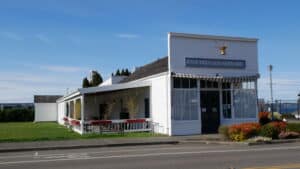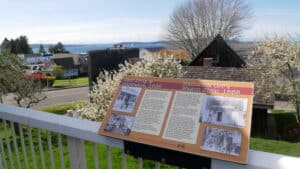National Heritage Areas are based on partnerships: bringing together a range of Tribes, organizations, businesses, and governments around heritage resources and stories. One of our partners is the Steilacoom Historical Museum Association. If you are interested in becoming a partner, learn more on our become a partner page.
Many cities in Washington State have long histories of early colonial settlement, but few can claim as many ‘firsts’ as Steilacoom. Thanks to the work of the Steilacoom Historical Museum Association, the history and culture of their town are well-documented and explorable through interpretive signage, hands-on activities, and three historic structures in addition to their central museum, all open to visitors at no charge.
Early History of Steilacoom
Between the 1830s and 1850s, white settlers began moving through the Oregon Territory and establishing villages near what would be called Steilacoom, often displacing native populations. In 1851, two years before the formation of the Washington Territory, a town was founded and named Steilacoom, an anglicized pronunciation of a native flower known to the indigenous population as č’tilqwɘbš (pronounced “CH’tilQWubSH”). Predating both Seattle and Tacoma, Steilacoom held many of the ‘firsts’ of what would become Washington State. First incorporated town, first brick building and jail, first school in Pierce County, and many others.



Between the 1860s and 1880s, Steilacoom was on its way to becoming a boom town. With its position as the county seat, three of the five major roads in the region passing through its boundaries, and a large port shipping plenty of lumber to San Francisco, Steilacoom had a decent chance at making it big. There was even discussion of Steilacoom becoming the state capitol. That chance was nixed in 1880 when Tacoma was selected as the terminus of the Northern Pacific Railway over Steilacoom.
Eventually, town goals shifted from trade to dreams of becoming a resort town, with access to beaches and even an aquarium on its piers. However, that future was also not in the cards for this small community. A railroad did eventually pass through Steilacoom, but its location right along the waterfront cut off most of the town from the shore. Today, only two access points exist: Sunnyside Beach Park and the ferry to Anderson and Ketron Islands.
Work of the Steilacoom Historical Museum Association
Today, the Steilacoom Historical Museum Association (SHMA) exists to enlighten visitors and residents about the past of their changed town. French Wetmore, former director of the SHMA, is one of the dedicated volunteers who keep the SHMA running. He’s working to get more people to visit the museum and learn about local history.
On weekends between April and August, the museum is staffed entirely by volunteer docents, most of whom live in town. They interpret the area’s history through four venues, each shaped to educate about the lived experiences of those who contributed to Steilacoom’s growth. Driving into town, visitors are greeted by the museum, the home of Nathaniel Orr, and his wagon shop within the first block. Just around the corner is the Bair Drug and Hardware Store, standing narrowly at the top of another hill overlooking the Puget Sound.



Between the museum and the Orr house is an orchard of pear, apple, plum, and cherry trees, some of which were planted by Nathaniel Orr more than 100 years ago. This inviting space is open year-round to the public, and visitors to the museum are welcome to picnic in one of the most picturesque views in the South Puget Sound. Providing spaces like this for community connection is important to those who volunteer for the SHMA. Their fundraising events, like their 4th of July ice cream social, salmon bake at Sunnyside Beach, and annual cider press “are really community activities,” said French.
Historic Structures
The museum houses the bulk of the SHMA collection of antiques and interpretive signage. Visitors can look at antique books, and clothes that schoolchildren would have worn are available for children to try on. An intricate model of a ship that contributed to the settlement of the area is backed by biographies of its owners and stories of its adventures. Adorning every wall are interpretive signs describing different decades and facets of the town’s history.
In addition to their permanent displays, the museum also houses rotating exhibits. This season’s exhibit is on loan from the Steilacoom Tribe, sharing their history of the region since time immemorial. The Steilacoom Tribal Museum & Cultural Center is a little further into Steilacoom and is currently closed for construction.
Next door to the museum is the Nathaniel Orr Pioneer Home, which was placed on the National Register of Historic Places in 1972. Originally built by Nathaniel Orr in 1857, much of the furniture and décor in the building is original. While tours of the home are escort-only, the SHMA hosts biennial Christmas parties there, inviting the community to visit and explore an 1870s Christmas. Nearby, Nathaniel Orr’s wagon shop was reconstructed by the SHMA in 1992. The SHMA uses this space to show what tools and methods early pioneers in the area would have used to construct and maintain their primary means of transportation through the Territory. The wide doors are opened to the public on weekends and community days.
The last property owned by the SHMA is the Bair Drug and Hardware store, which was originally built in 1895 by another one of Steilacoom’s oldest families. At the time, a trolley ran from Tacoma to Steilacoom to enhance its growth towards a resort town. According to French, the power for the electric lights of Bair Drug and Hardware (the first in all of Steilacoom) was drawn from the trolley’s power lines, so they would dim whenever the electric trolley came by. The dimming lights meant that visitors and residents would all get up from their chairs and stools to help turn the trolley back around for a return trip into Tacoma.
After relocating the building from a site closer to the water after the train tracks were placed, W.L. Bair added a soda fountain and ice cream shop. In 1973, the heirs of W.L. Bair donated the building to the SHMA. Today, it exists as a weekend breakfast and lunch restaurant, and the interior is a museum itself, still resembling that same drugstore.



Future and Past of the SHMA
The SHMA was established in 1970 because of an effort to protect artifacts from the town’s early history. “The original impetus was a collection of historic photos and a very small group of future members and officers that collected them and framed them and they hung them around town hall,” said French. The SHMA recently celebrated its 50th anniversary and is looking towards the future of the organization and its museums.
One of the ways the SHMA is moving into the future is through partnerships with other local museums to help bolster attendance across the region. They’re also exploring alternative ways to tell stories, such as their yearly Steilacoom ghost tour in October. “We’ve got a lot here that we don’t need to build something new, just get the word out for folks to come on over and take a look at what’s here,” said French



The SHMA celebrates Steilacoom: a place with a rich waterfront history shaped by the transportation of goods, establishment of community, and recognition of displaced native populations. By providing family-friendly expeditions into history, the SMHA connects residents and visitors alike with one of the most fascinating, walkable, historic towns in the Pacific Northwest.

